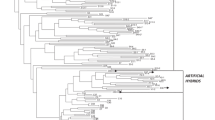Abstract
Relationships between Arracacia species were studied according to 28 morphological discriminant characters, in 90 accessions: 83 Arracacia (Arracacia elata, A. incisa and A. xanthorrhiza), and seven accessions of Neonelsonia acuminata, which has been confused with A. elata. The geographic distribution of the Arracacia species was determined from the passport data of the 90 accessions. A. elata was clearly differentiated from N. acuminata according to morphological characteristics. The species A. incisa was more closely related to A. xanthorrhiza. Within A. xanthorrhiza two forms, monocarpic, and polycarpic, were identified. The distribution of wild Arracacia species in Peru is characterized by two main ecological zones: (1) a dry zone, like the western Yunga and western and inter-Andean valleys of the Quechua region (with seasonal rain from November to March), where the species A. incisa and A. xanthorrhiza are present, and (2) a humid zone, like the Eastern Quechua where A. elata is adapted. These informations could be useful to establish strategies for in situ and ex situ conservation and management of germplasm.





Similar content being viewed by others
References
Blas R (2005) Diversity of Arracacia species in Peru. Ph.D. Thesis., Gembloux Agricultural University, Belgium, p 154
Blas R, Ghislain M, Herrera MR, Baudoin J-P (2007) Genetic diversity analysis of wild Arracacia species according to morphological and molecular markers. Genet Resour Crop Evol (in press)
Brako L, Zarucchi J (1993) Catálogo de las angiospermas y gimnospermas del Perú. Missouri Bot Gard, p 1286
Constance L (1949) The South American species of Arracacia (Umbelliferae) and some related genera. Bull Tor Bot Club 76(1):39–52
Constance L (1997) An instance of East-West confusion in chinese Umbelliferae, or Arracacia out of Asia. Edinb J Bot 54(1):99–104
Harris JG, Harris MW (2001) Plant identification terminology. An illustrated glossary, 2nd ed. Spring Lake Publishing, Utah, USA, p 206
Hermann M (1997) Arracacha (Arracacia xanthorrhiza Bancroft). In: Hermann M, Heller J (eds) Andean roots and tubers: Ahipa, arracacha, maca and yacon. Promoting the conservation and use of underutilized and neglected crops. 21. Institute of Plant Genetics and Crop Plant Research, Gatersleben/International Plant Genetic Resources Institute, Rome, Italy, p 75–172
Hijmans R, Guarino L, Bussink C, Barrantes I, Rojas E (2002) DIVA-GIS, Version 2. Sistema de Información Geográfica para el Análisis de Datos de Biodiversidad. Manual International Potato Center, Lima, Perú, p 67
Hodge WH (1954) The edible arracacha - a little-known root crop of the Andes. Econ Bot 8(3):195–221
Knudsen SR (2003) Reproduction biology of the Andean root crop arracacha (Arracacia xanthorrhiza Bancroft var. xanthorrhiza) and the taxonomic status of the South American Arracacia Bancroft species with special emphasis on the position of the cultivated arracacha and related wild species. Ph.D., Thesis. Botanical Section, Department of Ecology, The Royal Veterinary and Agricultural University. Copenhagen, Denmark, p 150
Lindley J (1951) Glosología de los términos usados en botánica. Traducido de la versión inglesa y aumentada con la terminología equivalente alemana por J. E. Rothe, Miscelánea N°15. Fundación Miguel Lillo, Instituto Miguel Lillo de la Universidad Nacional de Tucumán. Tucumán, Argentina, p 125
Mathias ME, Constance L (1962) Arracacia Bancroft. In: Mathias ME, Constance L (eds) Flora of Perú. Field Mus Nat Hist Bot 13(1) part V-A:13–19
National Research Council (1989) Arracacha. In: Lost crops of the Incas. Little known plants of the Andes with promise for worldwide cultivation. National Academy Press. Washington DC, p 46–55
Pulgar J (1987) Geografía del Perú. Las ocho Regiones Naturales. Novena Edición. Promoción Editorial Inca, S.A. (PEISA), Lima, Perú, p 244
Rohlf F (1994) NTSYS PC: numerical taxonomy and multivariate analysis for the IBM PC microcomputers (and compatibles), Version 1.80. User Manual. Stony Brook, New York, USA, p 240
Rohlf F (2000) NTSYS PC: numerical taxonomy and multivariate analysis for the IBM PC microcomputers (and compatibles), Version 2.1 User guide. Applied Biostatistics, Stony Brook, New York, USA, p 39
Royal Horticultural Society (RHS) (1995) Colour chart. London, UK
Salick J, Merrick LC (1990) Use and maintenance of genetic resources: crops and their wild relatives. In: Ronald Carroll C, Vandermur JH, Rosset PM (eds) Agroecology. Biological resource management. Mc Graw-Hill, NY, USA, p 517–548
Acknowledgements
This research was supported by grants from Coopération Universitaire au Développement (CUD) and Direction Générale de la Cooperation Internationale, Belgium.
Author information
Authors and Affiliations
Corresponding author
Rights and permissions
About this article
Cite this article
Blas, R., Hermann, M. & Baudoin, JP. Analysis of the geographic distribution and relationships among Peruvian wild species of Arracacia . Genet Resour Crop Evol 55, 643–655 (2008). https://doi.org/10.1007/s10722-007-9267-9
Received:
Accepted:
Published:
Issue Date:
DOI: https://doi.org/10.1007/s10722-007-9267-9




